Ultrathin non-doped thermally activated delayed fluorescence emitting layer for highly efficient OLEDs†
Abstract
We report highly efficient, ultrathin non-doped green and bluish-green organic light-emitting diodes (OLEDs) using a thermally activated delayed fluorescence (TADF) emitter. The green OLED with an ultrathin (∼1 nm) EML showed a 2.6-fold higher external quantum efficiency (EQEmax) of 13.5% with a luminance of 17 250 cd m−2 than the conventional (30 nm) non-doped device.

- This article is part of the themed collection: ChemComm Milestones – First Independent Articles


 Please wait while we load your content...
Please wait while we load your content...